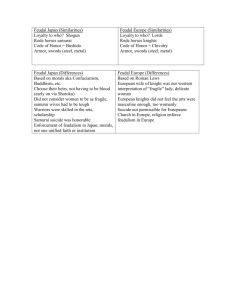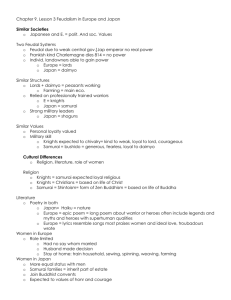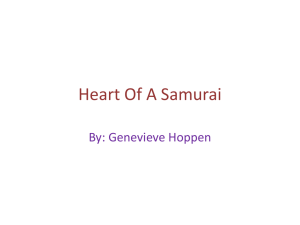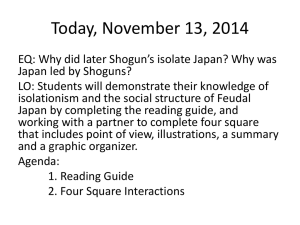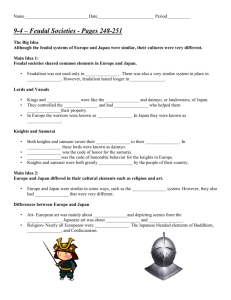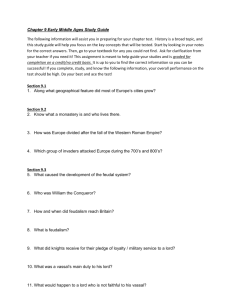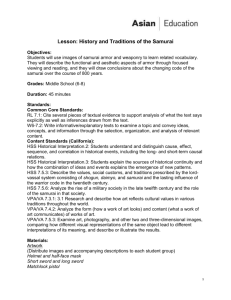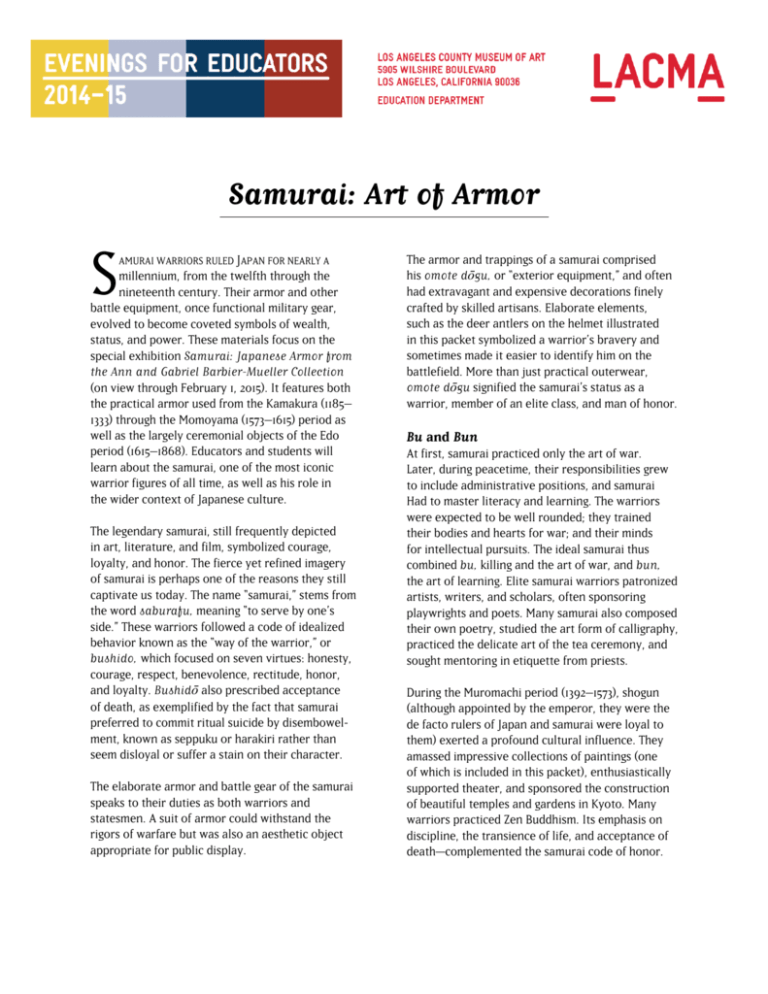
Samurai: Art of Armor
S
AMURAI WARRIORS RULED JAPAN FOR NEARLY A
millennium, from the twelfth through the
nineteenth century. Their armor and other
battle equipment, once functional military gear,
evolved to become coveted symbols of wealth,
status, and power. These materials focus on the
special exhibition Samurai: Japanese Armor from
the Ann and Gabriel Barbier-Mueller Collection
(on view through February 1, 2015). It features both
the practical armor used from the Kamakura (1185–
1333) through the Momoyama (1573–1615) period as
well as the largely ceremonial objects of the Edo
period (1615–1868). Educators and students will
learn about the samurai, one of the most iconic
warrior figures of all time, as well as his role in
the wider context of Japanese culture.
The legendary samurai, still frequently depicted
in art, literature, and film, symbolized courage,
loyalty, and honor. The fierce yet refined imagery
of samurai is perhaps one of the reasons they still
captivate us today. The name “samurai,” stems from
the word saburafu, meaning “to serve by one’s
side.” These warriors followed a code of idealized
behavior known as the “way of the warrior,” or
bushido, which focused on seven virtues: honesty,
courage, respect, benevolence, rectitude, honor,
and loyalty. Bushidō also prescribed acceptance
of death, as exemplified by the fact that samurai
preferred to commit ritual suicide by disembowelment, known as seppuku or harakiri rather than
seem disloyal or suffer a stain on their character.
The elaborate armor and battle gear of the samurai
speaks to their duties as both warriors and
statesmen. A suit of armor could withstand the
rigors of warfare but was also an aesthetic object
appropriate for public display.
The armor and trappings of a samurai comprised
his omote dōgu, or “exterior equipment,” and often
had extravagant and expensive decorations finely
crafted by skilled artisans. Elaborate elements,
such as the deer antlers on the helmet illustrated
in this packet symbolized a warrior’s bravery and
sometimes made it easier to identify him on the
battlefield. More than just practical outerwear,
omote dōgu signified the samurai’s status as a
warrior, member of an elite class, and man of honor.
Bu and Bun
At first, samurai practiced only the art of war.
Later, during peacetime, their responsibilities grew
to include administrative positions, and samurai
Had to master literacy and learning. The warriors
were expected to be well rounded; they trained
their bodies and hearts for war; and their minds
for intellectual pursuits. The ideal samurai thus
combined bu, killing and the art of war, and bun,
the art of learning. Elite samurai warriors patronized
artists, writers, and scholars, often sponsoring
playwrights and poets. Many samurai also composed
their own poetry, studied the art form of calligraphy,
practiced the delicate art of the tea ceremony, and
sought mentoring in etiquette from priests.
During the Muromachi period (1392–1573), shogun
(although appointed by the emperor, they were the
de facto rulers of Japan and samurai were loyal to
them) exerted a profound cultural influence. They
amassed impressive collections of paintings (one
of which is included in this packet), enthusiastically
supported theater, and sponsored the construction
of beautiful temples and gardens in Kyoto. Many
warriors practiced Zen Buddhism. Its emphasis on
discipline, the transience of life, and acceptance of
death—complemented the samurai code of honor.
Historic Rise . . . and Fall
Samurai, part of the elite members of society,
represented only eight percent of the population.
The rise of this warrior class in Japanese culture
initially resulted from the inward focus of the
emperor and his imperial court, neglecting many
administrative duties. Gradually, Japan became
fragmented into small, feudal domains controlled by
provincial lords or daimyo. They system was similar
to European feudalism, with castle lords and their
vassals. The daimyo in turn cultivated samurai to
help protect and maintain his lands. The increasingly
number of samurai created a surge in demand for
arms and armor as several craftsmen were needed
to make the many different elements required to
outfit men and horses. The imperial court would
become largely ceremonial, and by the end of the
twelfth century, Japan was governed by a military
government led by the shogun, or chief military ruler.
Eventually, the dress, cultural values, and traditions
of the samurai came to dominate Japan.
In 1853, American Commodore Matthew C. Perry
landed on the shores of Japan. He demanded trading
rights and forced the weak government to sign a
treaty with the United States. This opened Japan to
the US and the world. The Tokugawa shogunate was
overthrown during what became known as the Meiji
Restoration. In 1876, samurai were forbidden by law
to wear swords, something that had previously been
required and visually designated samurai as part of
the elite class. The samurai class was officially
dissolved during the Meiji period (1868–1912), but
the samurai’s experience in government and
administration allowed them to make vital
contributions to the emergence of a new, modern
Japan.
Four images of samurai armor and accoutrements
are provided here.
In 1543, a group of Portuguese sailors, whose ship
had been blown off course, landed on the coast of
Japan. With them, they brought the matchlock gun,
and Japanese warfare and samurai armor were
forever changed. Suddenly, traditional armor was
ineffective. In response to these new weapons of
war, small leather and iron plates gave way to
larger, full-frontal iron sheets similar to the armor
worn by European knights.
The Edo period (1615–1868) was a time of relative
peace accomplished by the Tokugawa shogunate
that would prove lasting. Samurai remained ready
for combat and kept their privileged status, but they
served more as bureaucrats and civil leaders than
active warriors. Armor became a leading symbol of
pageantry and prestige. Samurai would dress
themselves and their horses in full armor and carry
weapons for parades and the mandatory biannual
processions between their home domains and the
capital, Edo (present-day Tokyo). Since the size and
splendor of the convoys reflected a daimyo’s status,
significant resources were invested in creating
pieces of great artistic refinement meant to impress,
as seen in the included images of samurai cavalry.
Credits
These curriculum materials were prepared by Veronica
Alvarez and Holly Gillette, and designed by Jenifer Shell.
© 2014 Museum Associates/LACMA. All rights reserved.
Evenings for Educators is made possible by The Rose Hills
Foundation, the Joseph Drown Foundation, and the Kenneth
T. and Eileen L. Norris Foundation.
Education programs at the Los Angeles County Museum of
Art are supported in part by the William Randolph Hearst
Endowment Fund for Arts Education and the Margaret A.
Cargill Arts Education Endowment.



